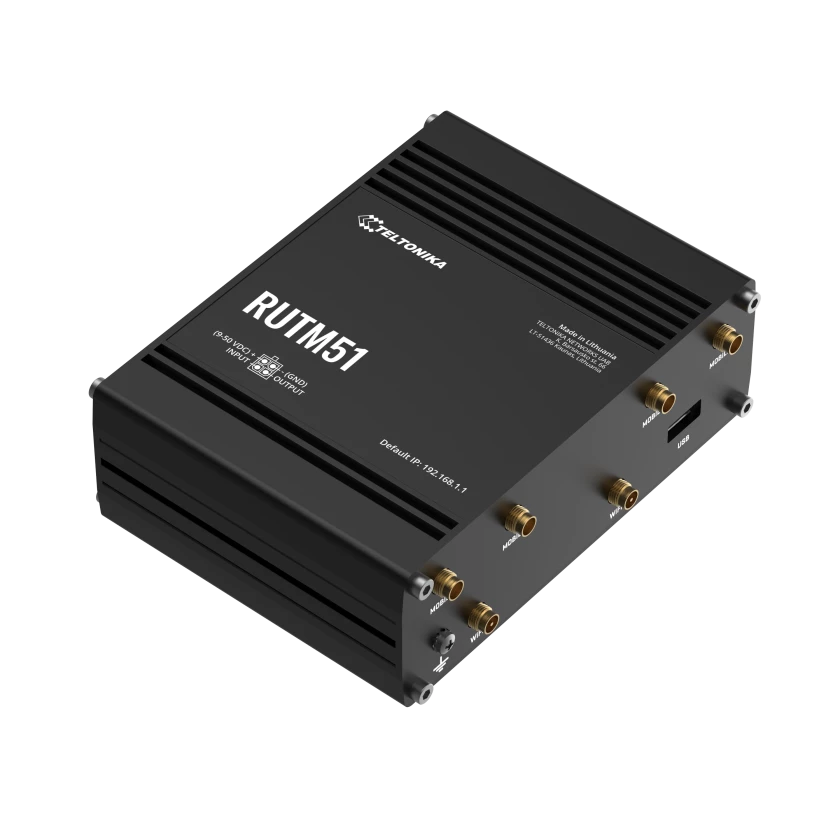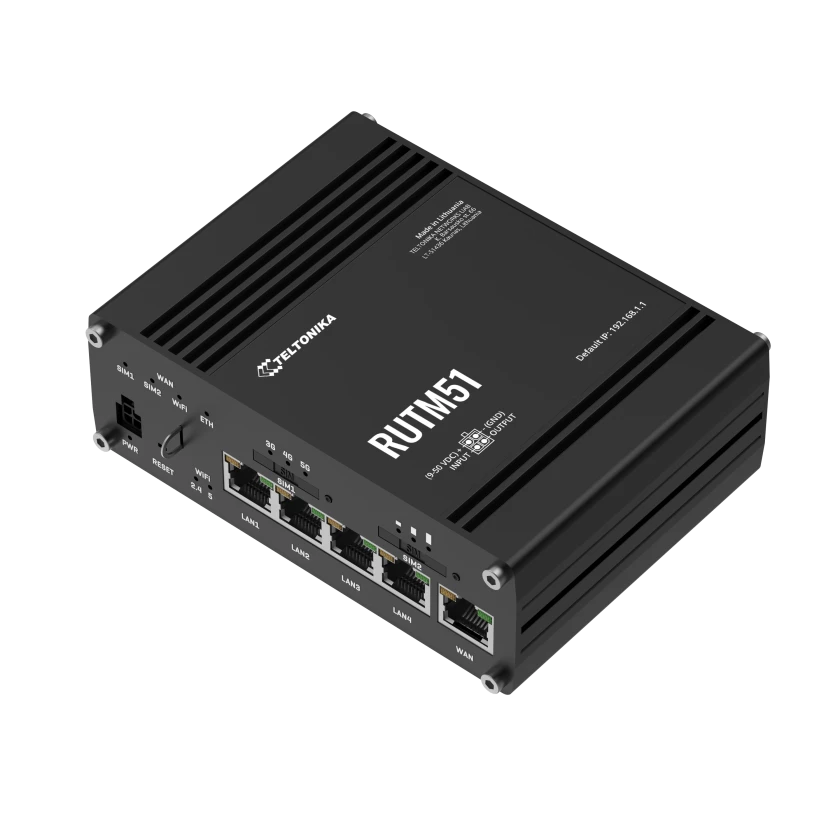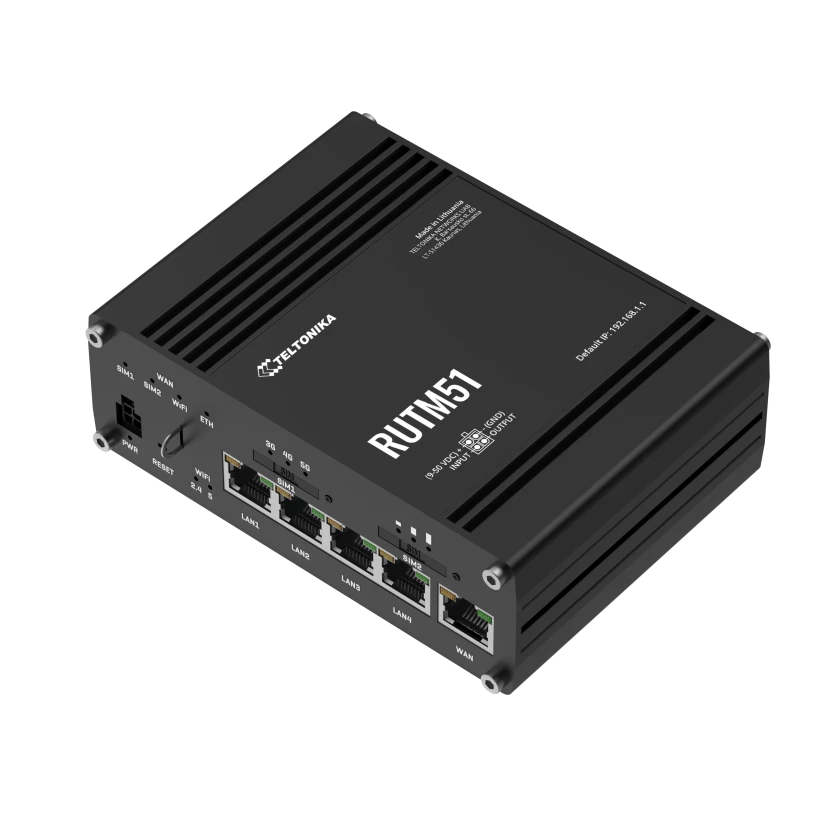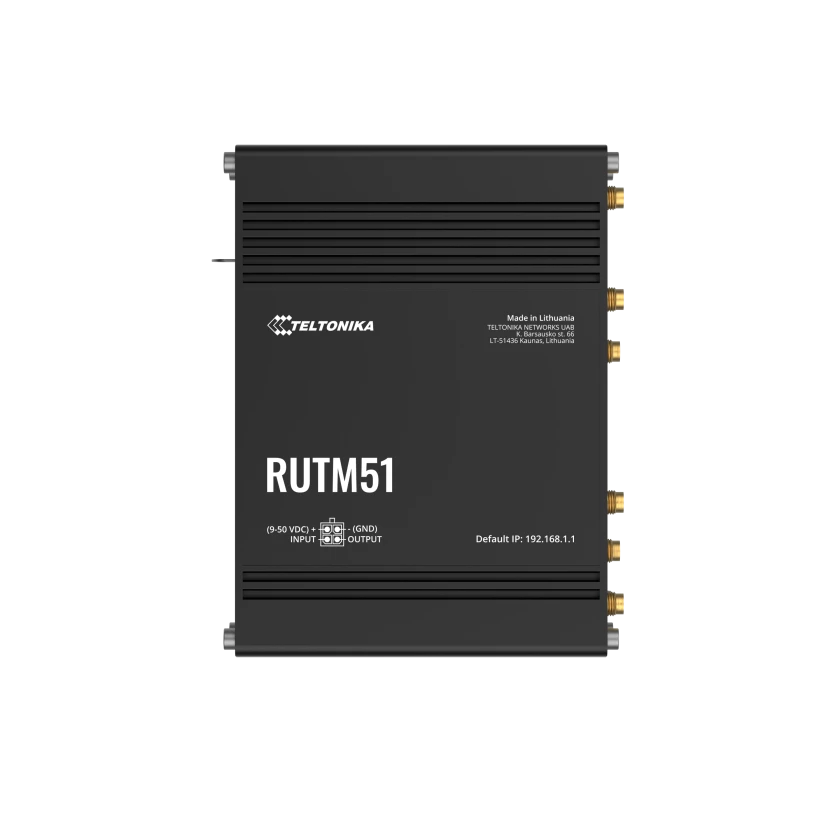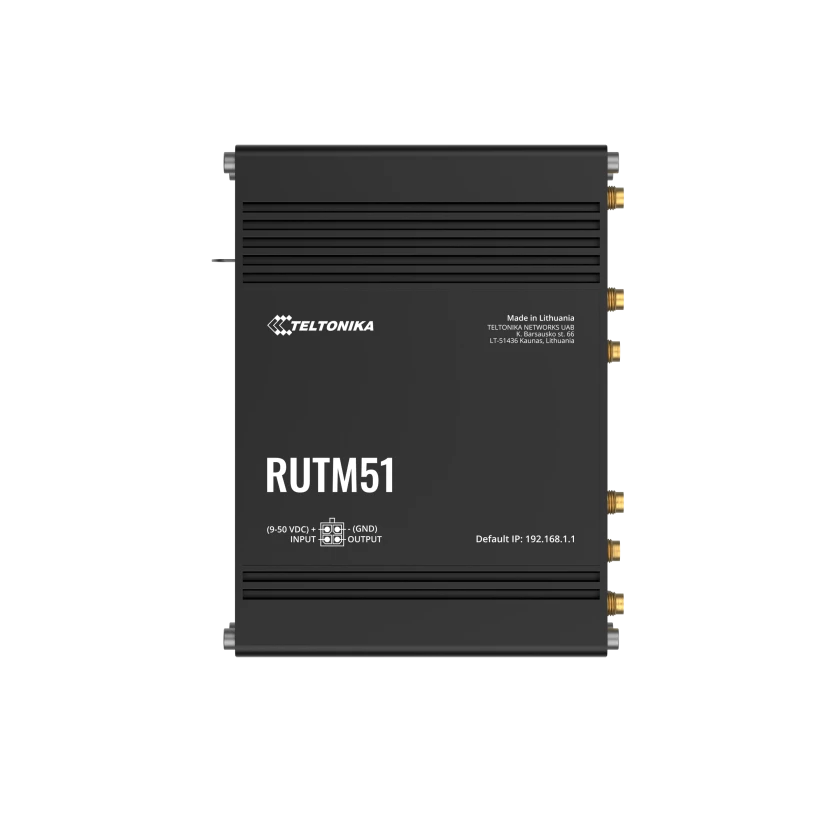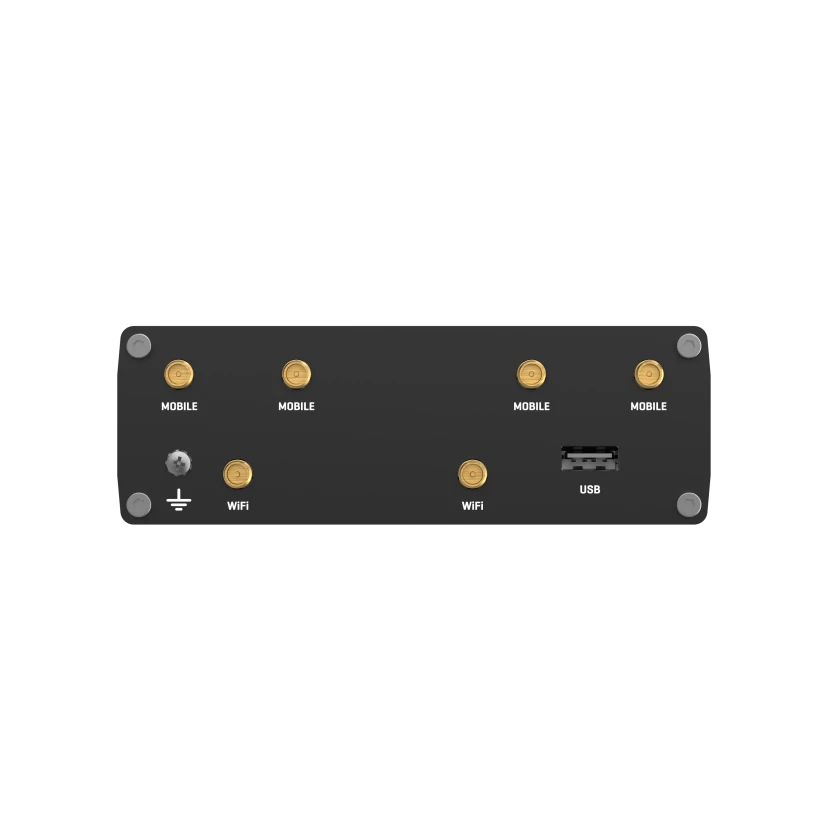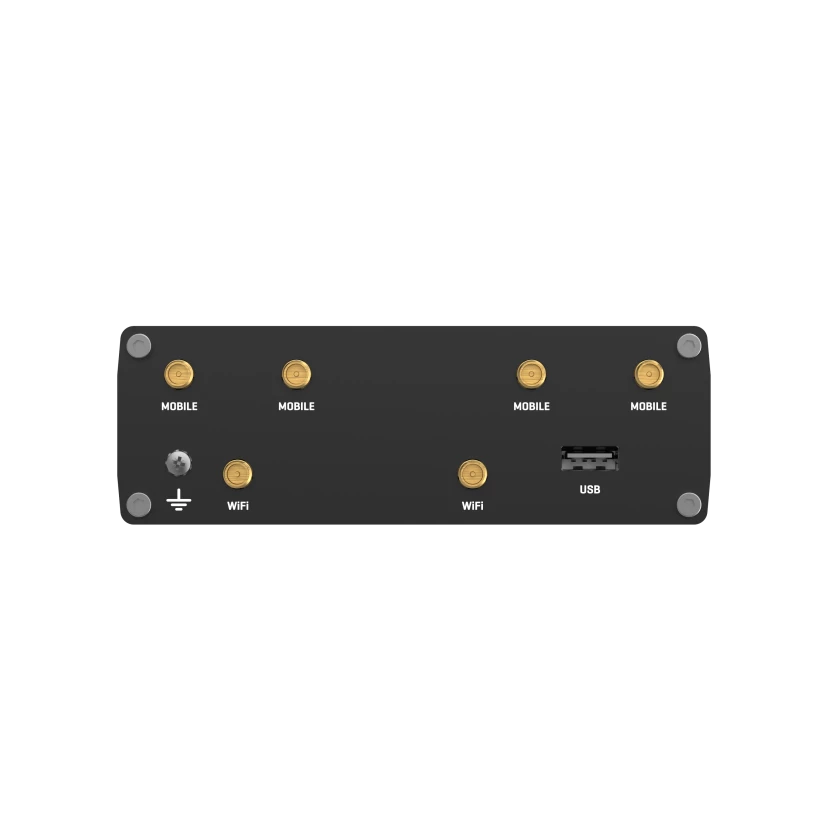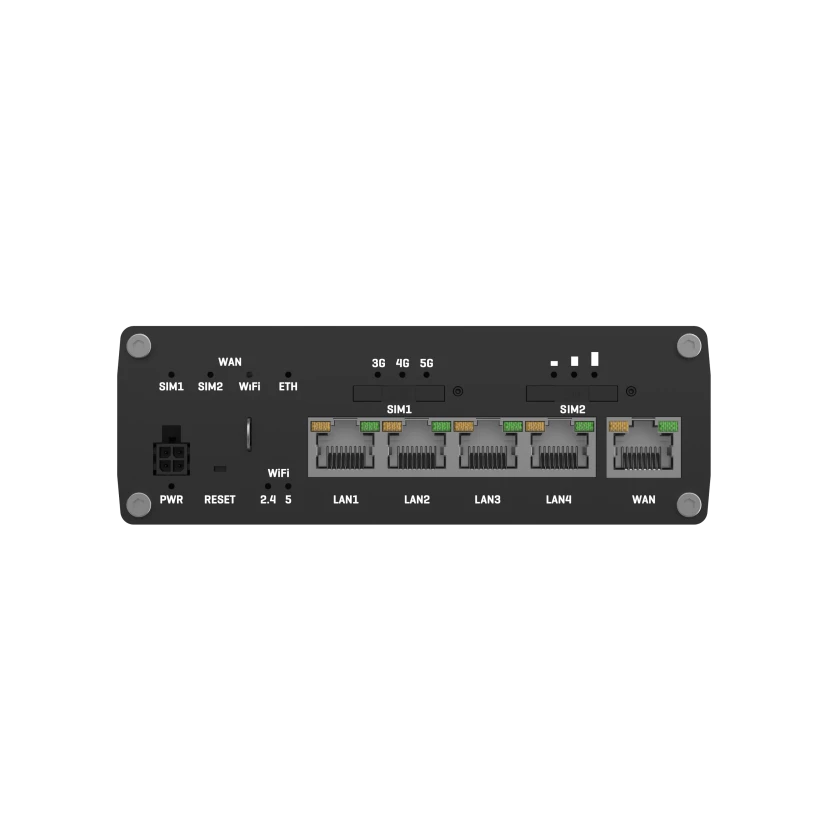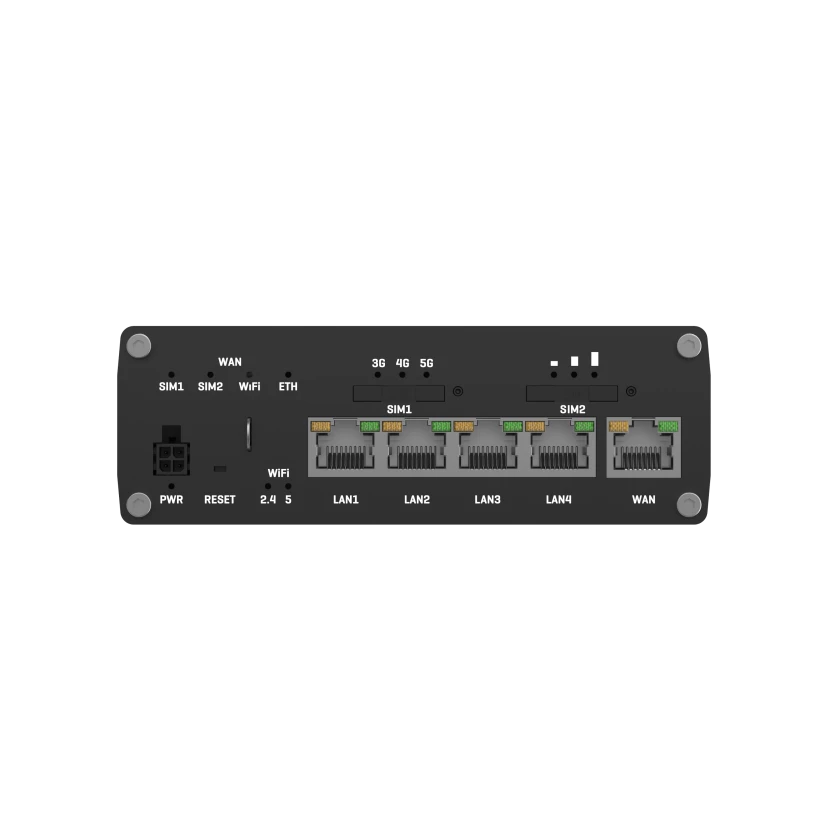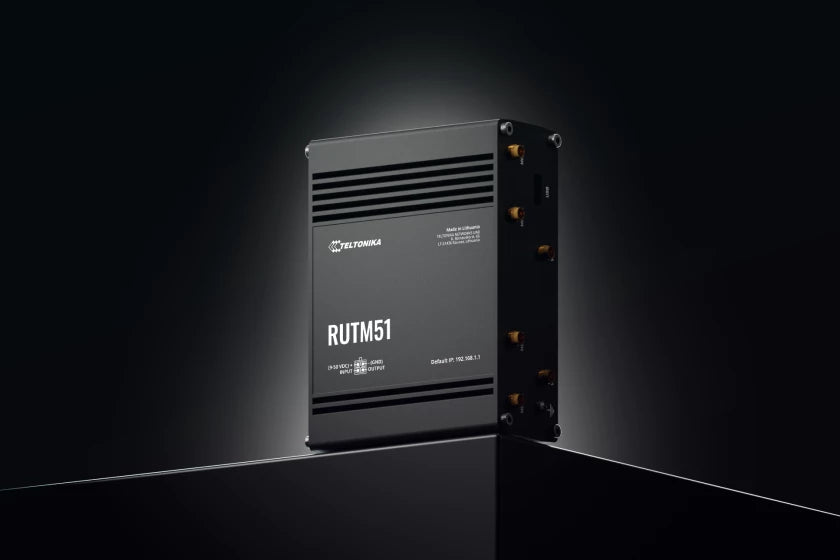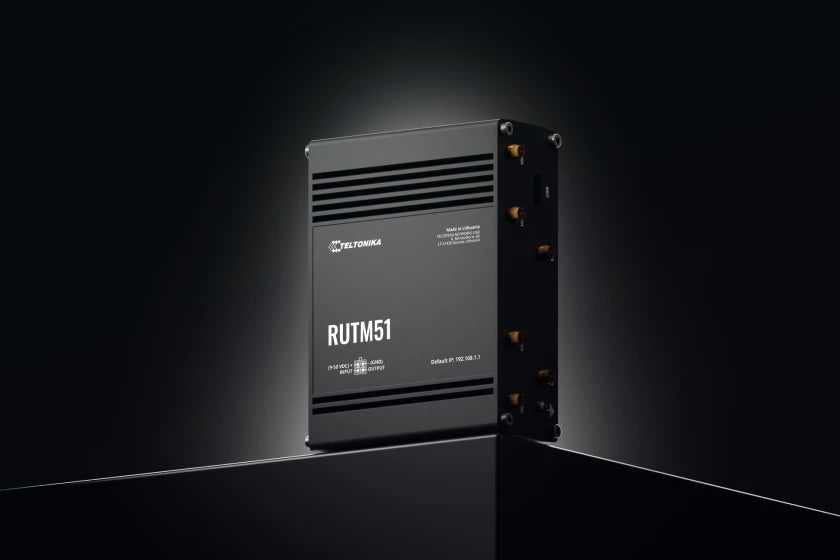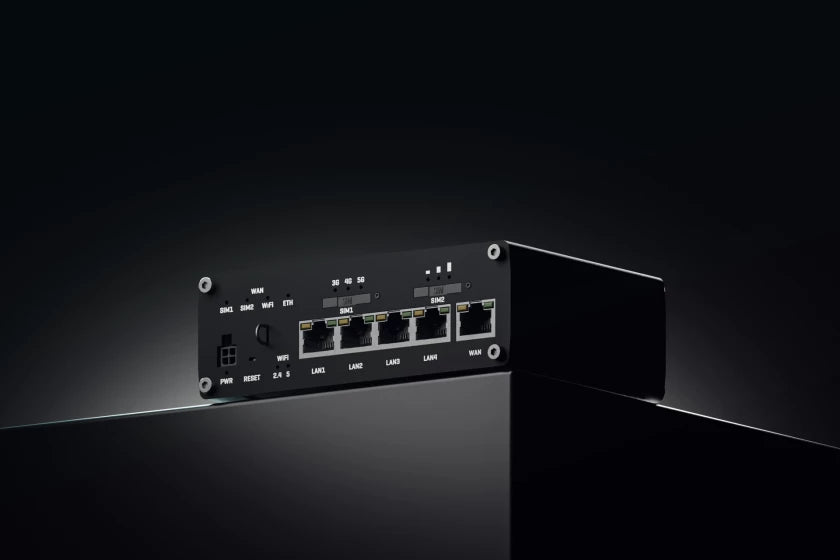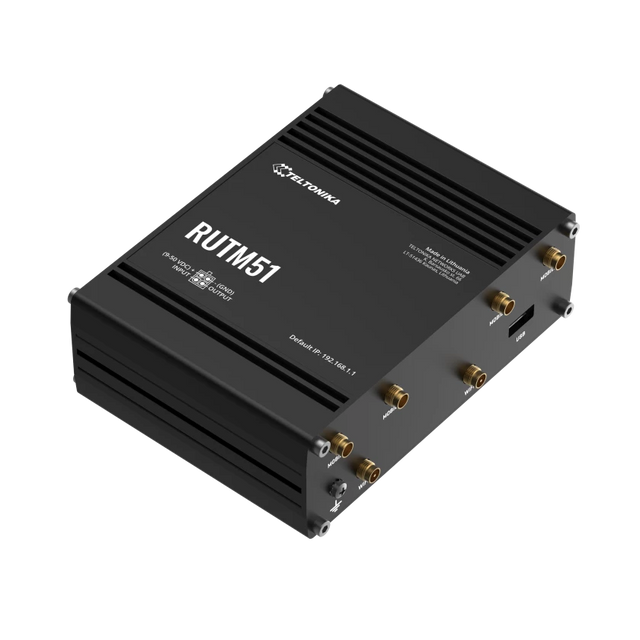Teltonika RUTM51, pramoninis 5G maršrutizatorius
Teltonika RUTM51, pramoninis 5G maršrutizatorius - prieš pirkdami pasiteiraukite ar šią prekę turime sandėlyje, jei neturime ji gali būti užsakyta ir atvykti per 2-21 dieną.
▪️ Turite klausimų dėl šios prekės❓Galime pakonsultuoti telefonu +370 683 90000, arba mūsų salone Armatūrininkų g. 1, Kaunas.
📩 Taip pat galite siųsti mums užklausą į kurią atsakysime per 24 val.
Pristatymas
Pristatymas
Lietuvoje siuntas pristatome iki durų Venipak kurjeriu per 1-2 darbo dienas, už 4.99€. Užsisakius virš 100€ - pristatymas nemokamas.
Siuntų pristatymas už Lietuvos ribų per 4-10 darbo dienų. Pristatymo kainos nuo 15.00€.
Prekių atsiėmimas parduotuvėje
Prekių atsiėmimas parduotuvėje
Užsakytas prekes internetu galite atsiimti mūsų parduotuvėje adresu Armatūrininkų g. 1, Kaunas. Turėkite su savimi užsakymo nr.
Prieš atvykstant rekomenduojame pasiskambinti +370 683 90000
Darbo laikas: I-V 9:00-18:00
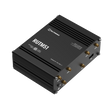
Teltonika RUTM51, pramoninis 5G maršrutizatorius
- INFORMACIJA
- TECHNINIAI DUOMENYS
Teltonika RUTM51 - yra dviejų SIM kortelių daugiatinklis pramoninis 5G maršrutizatorius, užtikrinantis ryšį gausių duomenų reikalaujantiems sprendimams, už ypač prieinamą kainą. Sklandus ir patikimas veikimas užtikrinamas pasitelkiant penkis gigabitinio eterneto prievadus, dviejų juostų „Wi-Fi“ ryšį bei automatinį perjungimą. Dėl atgalinio suderinamumo su 4G Cat 12 tinklu ir įvairiapusių sąsajų, RUTM51 5G maršrutizatorius yra geriausia investicija įmonėms, ieškančioms didelės spartos ryšio už gerokai žemesnę kainą.
EKONOMIŠKAS 5G
Aukščiausios klasės 5G greitis už neprilygstamą kainą
DU SIM LIZDAI
Automatinio persijungimo, atsarginio WAN bei kiti scenarijai
SA ir NSA
Palaiko abi architektūras siekiant didinti 5G infrastruktūros potencialą
ILGAAMŽIS SPRENDIMAS
Atgalinis suderinamas su 4G (iki LTE CAT 12) tinklo technologijomis
Mobile
Mobile module
5G Sub-6GHz SA: 2 Gbps DL, 1 Gbps UL; NSA: 2.6 Gbps DL, 650 Mbps UL; 4G (LTE) - Cat 12: 600 Mbps DL, Cat 13: 150 Mbps UL; 3G - 42.2 Mbps DL, 11 Mbps UL
3GPP Release
Release 15
SIM switch
2 SIM cards, auto-switch cases: weak signal, data limit, SMS limit, roaming, no network, network denied, data connection fail, SIM idle protection
Status
IMSI, ICCID, operator, operator state, data connection state, network type, CA indicator, bandwidth, connected band, signal strength (RSSI), SINR, RSRP, RSRQ, EC/IO, RSCP, data sent/received, LAC, TAC, cell ID, ARFCN, UARFCN, EARFCN, MCC, and MNC
SMS
SMS status, SMS configuration, send/read SMS via HTTP POST/GET, EMAIL to SMS, SMS to EMAIL, SMS to HTTP, SMS to SMS, scheduled SMS, SMS autoreply, SMPP
USSD
Supports sending and reading Unstructured Supplementary Service Data messages
Black/White list
Operator black/white list (by country or separate operators)
Band management
Band lock, Used band status display
SIM idle protection service
When working with devices with two SIM slots, the one not currently in use will remain idle until the device switches to it, meaning that no data is used on the card until then
SIM PIN code management
SIM PIN code management enables setting, changing, or disabling the SIM card's PIN
APN
Auto APN
Bridge
Direct connection (bridge) between mobile ISP and device on LAN
Passthrough
Router assigns its mobile WAN IP address to another device on LAN
Wireless
Wireless mode
802.11b/g/n/ac Wave 2 (Wi-Fi 5) with data transmission rates up to 867 Mbps (Dual Band, MU-MIMO), 802.11r fast transition, Access Point (AP), Station (STA)
Wi-Fi security
WPA2-Enterprise: PEAP, WPA2-PSK, WPA-EAP, WPA-PSK, WPA3-SAE, WPA3-EAP, OWE; AES-CCMP, TKIP, Auto-cipher modes, client separation, EAP-TLS with PKCS#12 certificates, disable auto-reconnect, 802.11w Protected Management Frames (PMF)
SSID/ESSID
ESSID stealth mode
Wi-Fi users
Up to 150 simultaneous connections
Wireless Connectivity Features
Wireless mesh (802.11s), fast roaming (802.11r), Relayd, BSS transition management (802.11v), radio resource measurement (802.11k)
Wireless MAC filter
Allowlist, blocklist
Wireless QR code generator
Once scanned, a user will automatically enter your network without needing to input login information
TravelMate
Forward Wi-Fi hotspot landing page to a subsequent connected device
Ethernet
WAN
1 x WAN port 10/100/1000 Mbps, compliance with IEEE 802.3, IEEE 802.3u, 802.3az standards, supports auto MDI/MDIX crossover
LAN
4 x LAN ports, 10/100/1000 Mbps, compliance with IEEE 802.3, IEEE 802.3u, 802.3az standards, supports auto MDI/MDIX crossover
Network
Routing
Static routing, Dynamic routing (BGP, OSPF v2, RIP v1/v2, EIGRP, NHRP), Policy based routing
Network protocols
TCP, UDP, IPv4, IPv6, ICMP, NTP, DNS, HTTP, HTTPS, SFTP, FTP, SMTP, SSL/TLS, ARP, VRRP, PPP, PPPoE, UPNP, SSH, DHCP, Telnet, SMPP, SNMP, MQTT, Wake On Lan (WOL), VXLAN
VoIP passthrough support
H.323 and SIP-alg protocol NAT helpers, allowing proper routing of VoIP packets
Connection monitoring
Ping Reboot, Wget Reboot, Periodic Reboot, LCP and ICMP for link inspection
Firewall
Port forward, traffic rules, custom rules, TTL target customisation
Firewall status page
View all your Firewall statistics, rules, and rule counters
Ports management
View device ports, enable and disable each of them, turn auto-configuration on or off, change their transmission speed, and so on
Network topology
Visual representation of your network, showing which devices are connected to which other devices
DHCP
Static and dynamic IP allocation, DHCP relay, DHCP server configuration, status, static leases: MAC with wildcards
QoS / Smart Queue Management (SQM)
Traffic priority queuing by source/destination, service, protocol or port, WMM, 802.11e
DDNS
Supported >25 service providers, others can be configured manually
DNS over HTTPS
DNS over HTTPS proxy enables secure DNS resolution by routing DNS queries over HTTPS
Network backup
Wi-Fi WAN, Mobile, VRRP, Wired options, each of which can be used as an automatic Failover
Load balancing
Balance Internet traffic over multiple WAN connections
Hotspot
Captive portal (hotspot), internal/external Radius server, Radius MAC authentication, SMS authorisation, SSO authentication, internal/external landing page, walled garden, user scripts, URL parameters, user groups, individual user or group limitations, user management, 9 default customisable themes and optionality to upload and download customised hotspot themes
SSHFS
Possibility to mount remote file system via SSH protocol
VRF support
Initial virtual routing and forwarding (VRF) support
Traffic Management
Real-time monitoring, wireless signal charts, traffic usage history
Security
Authentication
Pre-shared key, digital certificates, X.509 certificates, TACACS+, Internal & External RADIUS users authentication, IP & login attempts block, time-based login blocking, built-in random password generator
Firewall
Preconfigured firewall rules can be enabled via WebUI, unlimited firewall configuration via CLI, DMZ, NAT, NAT-T, NAT64
Attack prevention
DDOS prevention (SYN flood protection, SSH attack prevention, HTTP/HTTPS attack prevention), port scan prevention (SYN-FIN, SYN-RST, X-mas, NULL flags, FIN scan attacks)
VLAN
Port and tag-based VLAN separation
Mobile quota control
Mobile data limit, customizable period, start time, warning limit, phone number
WEB filter
Blacklist for blocking out unwanted websites, Whitelist for specifying allowed sites only
Access control
Flexible access control of SSH, Web interface, CLI and Telnet
SSL certificate generation
Let's Encrypt and SCEP certificate generation methods
802.1x
Port-based network access control client
VPN
OpenVPN
Multiple clients and a server can run simultaneously, 27 encryption methods
OpenVPN Encryption
DES-CBC 64, RC2-CBC 128, DES-EDE-CBC 128, DES-EDE3-CBC 192, DESX-CBC 192,
BF-CBC 128, RC2-40-CBC 40, CAST5-CBC 128, RC2-64-CBC 64, AES-128-CBC 128, AES-128-CFB 128, AES-128-CFB1 128, AES-128-CFB8 128, AES-128-OFB 128, AES-128-GCM 128, AES-192-CFB 192, AES-192-CFB1 192, AES-192-CFB8 192, AES-192-OFB 192, AES-192-CBC 192, AES-192-GCM 192, AES-256-GCM 256, AES-256-CFB 256, AES-256-CFB1 256, AES-256-CFB8 256, AES-256-OFB 256, AES-256-CBC 256
IPsec
XFRM, IKEv1, IKEv2, with 14 encryption methods for IPsec (3DES, DES, AES128, AES192, AES256, AES128GCM8, AES192GCM8, AES256GCM8, AES128GCM12, AES192GCM12, AES256GCM12, AES128GCM16, AES192GCM16, AES256GCM16)
GRE
GRE tunnel, GRE tunnel over IPsec support
PPTP, L2TP
Client/Server instances can run simultaneously, L2TPv3, L2TP over IPsec support
Stunnel
Proxy designed to add TLS encryption functionality to existing clients and servers without any changes in the program’s code
DMVPN
Method of building scalable IPsec VPNs, Phase 2 and Phase 3 and Dual Hub support
SSTP
SSTP client instance support
ZeroTier
ZeroTier VPN client support
WireGuard
WireGuard VPN client and server support
Tinc
Tinc offers encryption, authentication and compression in it's tunnels. Client and server support.
Tailscale
Tailscale offers speed, stability, and simplicity over traditional VPNs. Encrypted point-to-point connections using the open source WireGuard protocol
OPC UA
Supported modes
Client, Server
Supported connection types
TCP
MODBUS
Supported modes
Server, Client
Supported connection types
TCP, USB
Custom registers
MODBUS TCP custom register block requests, which read/write to a file inside the router, and can be used to extend MODBUS TCP Client functionality
Supported data formats
8-bit: INT, UINT; 16-bit: INT, UINT (MSB or LSB first); 32-bit: float, INT, UINT (ABCD (big-endian), DCBA (little-endian), CDAB, BADC), HEX, ASCII
DATA TO SERVER
Protocol
HTTP(S), MQTT, Azure MQTT, Kinesis
Data to server
Extract parameters from multiple sources and different protocols, and send them all to a single server; Custom LUA scripting, allowing scripts to utilize the router's Data to server feature
MQTT Gateway
Modbus MQTT Gateway
Allows sending commands and receiving data from MODBUS Server through MQTT broker
DNP3
Supported modes
Station, Outstation
Supported connection
TCP, USB
DLMS
DLMS Support
DLMS - standard protocol for utility meter data exchange
Supported modes
Client
Supported connection types
TCP
COSEM
Allows to scan meter COSEM objects for automatic detection and configuration
API
Teltonika Networks Web API (beta) support
Expand your device's possibilities by using a set of configurable API endpoints to retrieve or change data. For more information, please refer to this documentation: https://developers.teltonika-networks.com
Monitoring & Management
WEB UI
HTTP/HTTPS, status, configuration, FW update, CLI, troubleshoot, multiple event log servers, firmware update availability notifications, event log, system log, kernel log, Internet status
FOTA
Firmware update from server, automatic notification
SSH
SSH (v1, v2)
SMS
SMS status, SMS configuration, send/read SMS via HTTP POST/GET
Call
Reboot, Status, Mobile data on/off, Output on/off, answer/hang-up with a timer, Wi-Fi on/off
TR-069
OpenACS, EasyCwmp, ACSLite, tGem, LibreACS, GenieACS, FreeACS, LibCWMP, Friendly tech, AVSystem
MQTT
MQTT Broker, MQTT publisher
SNMP
SNMP (v1, v2, v3), SNMP Trap, Brute force protection
JSON-RPC
Management API over HTTP/HTTPS
MODBUS
MODBUS TCP status/control
RMS
Teltonika Remote Management System (RMS)
IoT Platforms
ThingWorx
Allows monitoring of: WAN Type, WAN IP, Mobile Operator Name, Mobile Signal Strength, Mobile Network Type
Cumulocity - Cloud of Things
Allows monitoring of: Device Model, Revision and Serial Number, WAN Type and IP, Mobile Cell ID, ICCID, IMEI, Connection Type, Operator, Signal Strength. Has reboot and firmware upgrade actions
Azure IoT Hub
Can be configured with Data to Server to send all the available parameters to the cloud. Has Direct method support which allows to execute RutOS API calls on the IoT Hub. Also has Plug and Play integration with Device Provisioning Service that allows zero-touch device provisioning to IoT Hubs
AWS IoT Core
Utility to interact with the AWS cloud platform. Jobs Support: Call the device's API using AWS Jobs functionality
System Characteristics
CPU
MediaTek, Dual-core, 880 MHz, MIPS1004Kc
RAM
256 MB, DDR3
FLASH storage
16 MB serial NOR flash, 256 MB serial NAND flash
Firmware / Configuration
WEB UI
Update FW from file, check FW on server, configuration profiles, configuration backup
FOTA
Update FW
RMS
Update FW/configuration for multiple devices at once
Keep settings
Update FW without losing current configuration
Factory settings reset
A full factory reset restores all system settings, including the IP address, PIN, and user data to the default manufacturer's configuration
FIRMWARE CUSTOMISATION
Operating system
RutOS (OpenWrt based Linux OS)
Supported languages
Busybox shell, Lua, C, C++
Development tools
SDK package with build environment provided
GPL customization
You can create your own custom, branded firmware and web page application by changing colours, logos, and other elements in our firmware to fit your or your clients’ needs
Package Manager
The Package Manager is a service used to install additional software on the device
USB
Data rate
USB 2.0
Applications
Samba share, USB-to-serial
External devices
Possibility to connect external HDD, flash drive, additional modem, printer, USB-serial adapter
Storage formats
FAT, FAT32, exFAT, NTFS (read-only), ext2, ext3, ext4
Input / Output
Input
1 x Configurable digital Input, 0 - 6 V detected as logic low, 8 - 50 V detected as logic high
Output
1 x Configurable digital Output, Open collector output, max output 50 V, 300 mA
Events
Email, RMS, SMS
I/O juggler
Allows to set certain I/O conditions to initiate event
Power
Connector
4-pin industrial DC power socket
Input voltage range
9 – 50 VDC, reverse polarity protection, surge protection >51 VDC 10us max
PoE (passive)
Possibility to power up through LAN1 port, not compatible with IEEE802.3af, 802.3at and 802.3bt standards, Mode B, 9 - 50 VDC
Power consumption
Idle: <5 W, Max: <18 W
Physical Interfaces
Ethernet
5 x RJ45 ports, 10/100/1000 Mbps
I/O’s
1 x Digital Input, 1 x Digital Output on 4-pin power connector
Status LEDs
4 x WAN type, 3 x Mobile connection type, 3 x Mobile connection strength, 10 x Ethernet port status, 1 x Power, 2 x 2.4G and 5G Wi-Fi
SIM
2 x SIM slots (Mini SIM – 2FF), 1.8 V/3 V
Power
1 x 4-pin power connector
Antennas
4 x SMA for Mobile, 2 x RP-SMA for Wi-Fi
USB
1 x USB A port for external devices
Reset
Reboot/User default reset/Factory reset button
Other
1 x Grounding screw
Physical Specification
Casing material
Aluminium housing
Dimensions (W x H x D)
132 x 44.2 x 95 mm
Weight
525 g
Mounting options
DIN rail, wall mount, flat surface (all require additional kit)
Operating Environment
Operating temperature
-40 °C to 75 °C
Operating humidity
10% to 90% non-condensing
Ingress Protection Rating
IP30
Regulatory & Type Approvals
CE, UKCA, EAC, UCRF, RCM, WEEE, CB
EMC Emissions & Immunity
Standards
EN 55032:2015+ A11:2020 + A1:2020
EN 55035:2017+A11:2020
EN 61000-3-3:2013+A1:2019+A2:2021
EN IEC 61000-3-2:2019+A1:2021
EN 301 489-1 V2.2.3
EN 301 489-3 V2.3.2
EN 301 489-17 V3.2.4
EN 301 489-52 V1.2.1
AS/NZS CISPR 32:2015+A1:2020
ESD
EN 55032:2015+ A11:2020 + A1:2020
EN 55035:2017+A11:2020
EN 61000-3-3:2013+A1:2019+A2:2021
EN IEC 61000-3-2:2019+A1:2021
EN 301 489-1 V2.2.3
EN 301 489-3 V2.3.2
EN 301 489-17 V3.2.4
EN 301 489-52 V1.2.1
AS/NZS CISPR 32:2015+A1:2020
Radiated Immunity
EN 61000-4-3:2006 + A1:2008 + A2:2010, EN IEC 61000-4-3:2020
EFT
EN 61000-4-4:2012, EN 61000-4-4:2012
Surge Immunity (AC Mains Power Port)
EN 61000-4-5:2014+A1:2017, EN 61000-4-5:2014+A1:2017
CS
EN 61000-4-6:2014
DIP
EN 61000-4-11:2020
RF
Standards
EN 300 328 V2.2.2
EN 301 893 V2.1.1
EN 300 440 V2.2.1
EN 301 908-1 V15.2.1
EN 301 908-2 V13.1.1
EN 301 908-13 V13.2.1
EN 301 908-25 V15.1.1
AS/NZS 4268:2017+A1:2021
AS/CA S042.1:2022
AS/CA S042.4:2022
AS/CA S042.5:2022+A1:2022
FCC Part 22
Safety
Standards
EN IEC 62311:2020
EN IEC 62368-1:2020+A11:2020
AS/NZS 2772.2:2016+A1:2018

